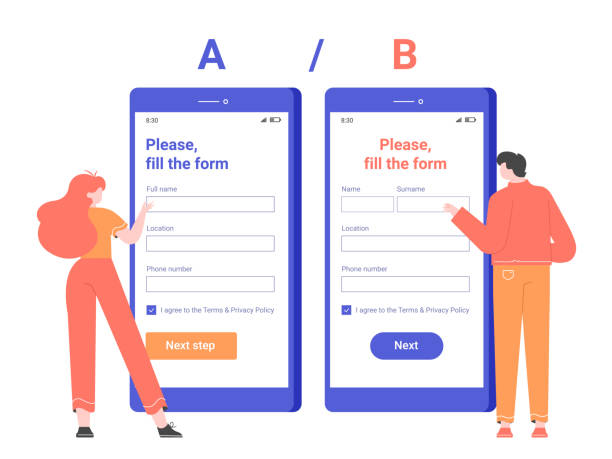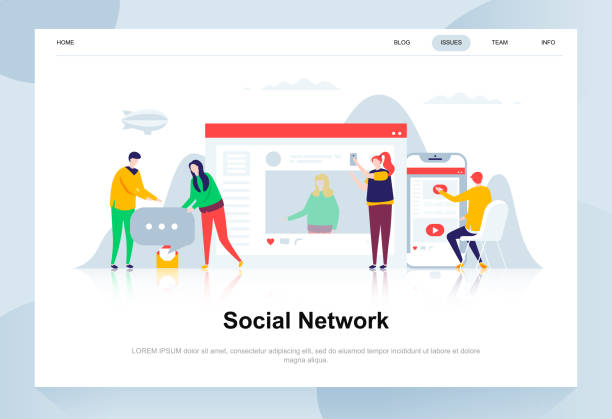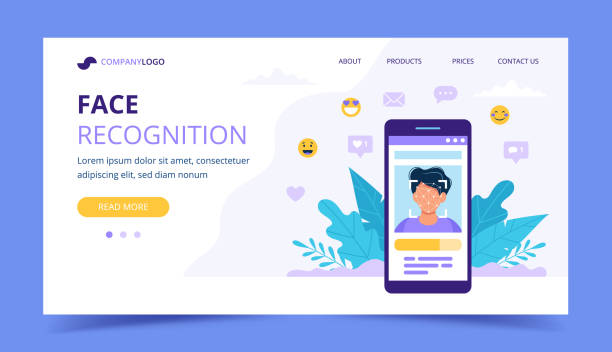An Introduction to the Importance of Secure Website Design

In today’s digital world, where businesses are increasingly migrating to the web, #Cybersecurity and #Data_Protection are considered the main pillars of success and survival.
Secure website design is no longer a luxury option, but a vital necessity for any website that processes user information or provides online services.
Its importance lies not only in maintaining customer credibility and trust, but also in playing a key role in preventing financial and legal damages resulting from data breaches and cyberattacks.
An insecure site can easily become a target for attackers, leading to the theft of sensitive information, service outages, or even damage to business infrastructure.
This section provides a comprehensive explanation of the fundamental necessities in the field of website cybersecurity.
Designing a website with a security approach from the outset is far less costly than fixing vulnerabilities after launch.
Furthermore, it significantly helps in strengthening the brand and creating a sense of peace of mind for users.
The main goal is to build a platform that is resilient against various threats and preserves valuable data.
This domain includes a wide range of protocols, best practices, and tools, all moving towards a common goal: creating a secure environment for online interactions.
Remember, secure website design is an ongoing process, not a one-time step.
Does your current e-commerce website design lead to loss of customers and sales?
Rasaweb is your solution with modern and user-friendly e-commerce website designs!
✅ Significant increase in conversion rates and sales
✅ Strong branding and building customer trust
⚡ Get free e-commerce website design consultation from Rasaweb!
Identifying Common Threats and Web Vulnerabilities

A correct understanding of the types of threats is the first step on the path to secure website design.
#Cyber_attacks #Vulnerabilities can take various forms, from SQL injection aimed at database access to XSS (Cross-Site Scripting) attacks that inject malicious code into users’ browsers.
DDoS attacks also threaten websites by aiming to take services offline through a massive volume of traffic.
Even weaknesses in Session Management or incorrect server configurations can open the way for intruders.
The analytical content section in this regard analyzes common attack scenarios and provides methods for identifying and countering them.
Understanding these vulnerabilities helps developers anticipate necessary security measures during coding and system architecture.
For example, the lack of user input validation is one of the most common causes of vulnerability, which can lead to injection attacks or cross-site scripting.
Furthermore, using outdated components or libraries with known vulnerabilities can create a serious weakness.
To counter these threats, a comprehensive and multi-layered approach is required, including regular security reviews and continuous updates.
Any negligence in this area can lead to disastrous consequences for the business and its users.
Finally, continuous training of the development team on the latest threats and best security practices plays a vital role in strengthening the sustainability of secure website design.
Fundamental Principles of Secure Design and System Architecture

To implement secure website design, fundamental security principles must be considered from the very initial stages.
#Security_Principles #Defense_in_Depth These principles include “Least Privilege,” “Separation of Duties,” and “Defense in Depth.”
This specialized approach means creating multiple security layers, so that even if one layer is breached, other layers can protect the system.
Secure architecture includes logical and physical separation of components, use of Virtual Private Networks (VPNs) for sensitive access, and implementation of powerful firewalls.
Furthermore, vulnerability management tools and security scanners should be used regularly.
In database design, encrypting sensitive information and using strong encryption methods for passwords are essential.
This section delves into how to integrate these principles into the software development lifecycle.
Every design decision must be made with its security implications in mind.
For example, when choosing frameworks and libraries, special attention should be paid to their security track record.
Continuous training for developers on these principles, ensuring that all team members are familiar with the importance of security and apply best practices in their work, is vital.
This preventive approach forms the basis of a resilient secure website design and prevents many future security problems.
Table: Common Web Vulnerabilities and Prevention Methods

| Vulnerability | Description | Prevention Methods |
|---|---|---|
| SQL Injection | Injecting malicious SQL code to access or manipulate the database. | Using Prepared Statements/Parameterized Queries, input validation, using ORM. |
| Cross-Site Scripting (XSS) | Injecting malicious scripts into web pages that are executed by the user’s browser. | Validating and filtering inputs, encoding outputs (HTML entity encoding). |
| Broken Authentication | Weaknesses in authentication mechanisms (e.g., session management, passwords). | Strong passwords, Multi-Factor Authentication (MFA), secure session management. |
| Sensitive Data Exposure | Disclosure of confidential information such as financial or personal data. | Encrypting data in transit and at rest, precise access control. |
| Security Misconfiguration | Incorrect configurations of servers, frameworks, applications, or databases. | Removing unnecessary services, applying security patches, using Hardening Guidelines. |
Does your company’s website perform as it should for your brand? In today’s competitive world, your website is your most important online tool. Rasaweb, specializing in professional corporate website design, helps you to:
✅ Build credibility and customer trust
✅ Convert website visitors into customers
⚡ Get a free consultation!
Server-Side and Database Security

Server-side and database security is the heart of any secure website design.
#Server_Configuration #Data_Encryption This is where vital data is stored and processed, and any breach in this layer can be disastrous.
To secure the server, secure configurations (Hardening) should be used, unnecessary services disabled, and open ports minimized.
The use of powerful firewalls, Intrusion Detection Systems (IDS), and Intrusion Prevention Systems (IPS) is essential for monitoring network traffic and identifying suspicious activities.
In the context of databases, encrypting sensitive information, applying the Principle of Least Privilege for database users, and performing regular, secure backups are of particular importance.
The guidance section in this area emphasizes the necessity of continuous updates to operating systems, server software, and databases to prevent known vulnerabilities.
Monitoring logs and detecting unusual patterns in data access can also reveal early signs of attacks.
Choosing secure database management systems and configuring them correctly according to best practices are other key aspects in this section.
Furthermore, ensuring that there are no default or weak passwords in the system and that access to servers is only possible through secure methods such as SSH with public key authentication, are requirements for website security on the server-side.
Securing Client-Side and Inputs

Client-side security and input validation play a vital role in completing the principles of website security.
#Input_Validation #Browser_Security Many attacks such as XSS (Cross-Site Scripting) and CSRF (Cross-Site Request Forgery) can be carried out through invalid inputs or weaknesses in client-side interactions.
To counter these threats, all user inputs – from contact forms to search fields – must be carefully validated and filtered.
This means sanitizing data to remove any malicious code or unsafe characters.
Using Content Security Policy (CSP) can also help browsers prevent the execution of unwanted code.
This section provides a comprehensive tutorial on best practices for input validation and secure front-end coding.
Furthermore, the transmission of sensitive information in plaintext should be prevented, and all communications should be conducted over HTTPS.
Preventing CSRF attacks by using anti-CSRF tokens in forms and requests is also of high importance.
Additionally, educating users on how to identify phishing emails and malicious links can help reduce client-side risks.
Finally, paying attention to small details on the front-end and understanding how attackers exploit user interface weaknesses significantly helps strengthen the overall secure approach in website design.
This security layer is the first line of defense against many common threats.
Authentication and Authorization Mechanisms

Authentication and authorization are two main pillars in secure web development that determine who has access to the system and what they can do.
#Authentication #Authorization Authentication mechanisms should be strong and multi-layered; using complex passwords, mandatory password change policies, and especially Multi-Factor Authentication (MFA), significantly enhances user account security.
Secure password storage, instead of direct storage, should be done through hashing and salting.
The explanatory section in this regard describes how to correctly implement these mechanisms.
Authorization also involves precisely defining access for each user or user group based on their role (Role-Based Access Control – RBAC) to ensure that each individual only accesses the resources required for their tasks.
This approach prevents unauthorized access and internal abuses.
Furthermore, user session management must be secure; using secure tokens, regular session expiration, and monitoring for unusual activities in sessions are of high importance.
Implementing CAPTCHA to prevent Brute Force attacks on login pages is also an important security measure.
Continuous review of authentication and authorization logs can help identify intrusion attempts or suspicious activities.
Ultimately, these mechanisms are vital for maintaining data integrity and confidentiality in a website security context and must be implemented with high precision.
Data Encryption in Transit and at Rest
![]()
Data encryption is a fundamental element in website security and the protection of sensitive information, whether in transit between the server and user or at rest on the server.
#Data_Encryption #SSL_Certificate Using HTTPS protocol with a valid SSL/TLS certificate for all web communications protects data in transit from eavesdropping and tampering.
These certificates create a security layer that ensures data is transmitted encrypted and the server’s authenticity is verified.
This section provides a comprehensive tutorial on the types of SSL certificates and how to implement them correctly.
For Data at Rest, such as information stored in databases or files on the server, using Full Disk Encryption or Application-Level Encryption methods is essential.
Encrypting sensitive files and users’ personal information prevents their disclosure, even in case of unauthorized access to the server.
Encryption key management is also of particular importance; keys must be securely stored and managed.
Strong encryption algorithms such as AES-256 should be used.
Implementing End-to-End encryption for sensitive communications can also elevate security to a higher level.
This dual approach (encryption in transit and at rest) ensures that data is protected throughout all stages of its lifecycle, from entry to storage and retrieval, forming the backbone of a secure website design.
Educating the team about the importance and correct methods of encryption is also essential.
Does your current e-commerce website design not generate the expected sales for you?
Rasaweb specializes in professional e-commerce website design!
✅ An attractive and user-friendly website aimed at increasing sales
✅ High speed and security for an ideal shopping experience⚡ Get a free online store design consultation with Rasaweb!
Table: Common Encryption Methods and Applications

| Encryption Method | Type | Main Application | Advantages |
|---|---|---|---|
| AES (Advanced Encryption Standard) | Symmetric | Encrypting data at rest (databases, files), secure communications. | High speed, strong security (with appropriate key). |
| RSA (Rivest-Shamir-Adleman) | Asymmetric | Encrypting symmetric keys, digital signatures, authentication. | Ensuring confidentiality and authenticity, use in SSL/TLS. |
| SHA (Secure Hash Algorithm) | Hashing | Generating hashes from passwords, validating data integrity. | One-way (irreversible), detecting data changes. |
| TLS (Transport Layer Security) | Network Protocol | Securing communications between client and server (HTTPS). | Encrypting data in transit, server authentication. |
Security Testing and Continuous Updates

After implementing secure website design, the work is not over; security is an ongoing process.
#Security_Testing #Security_Patch Performing regular security tests, including Penetration Testing, Vulnerability Scanning, and Code Review, is crucial for identifying weaknesses before attackers discover them.
This informative process helps us stay aware of the latest threats and known vulnerabilities.
Furthermore, continuous updates to operating systems, frameworks, libraries, and all software components of the website are essential to combat new vulnerabilities.
Many attacks exploit weaknesses for which security patches have already been released.
Using patch management tools and security alert systems can facilitate this process.
Planning for an Incident Response Plan is also highly important, so that in the event of a security breach, a rapid response with minimal damage can be achieved.
This includes procedures for identification, containment, eradication, and recovery.
Investing in training the development and operations team to be aware of the latest threats and best security practices is a fundamental step in ensuring the stability and resilience of secure website design against attacks.
Security is dynamic and requires continuous attention and updates.
Frequently Asked Questions
| Question | Answer |
|---|---|
| 1. What does secure website design mean? | Secure website design means creating a website that is resilient against cyberattacks and protects user and server information. |
| 2. Why is security important in website design? | To prevent data breaches, protect user privacy, maintain user trust, and avoid financial and reputational losses. |
| 3. What are the most common web vulnerabilities? | SQL Injection, Cross-Site Scripting (XSS), Cross-Site Request Forgery (CSRF), Broken Authentication, and Security Misconfiguration. |
| 4. How can SQL Injection be prevented? | By using Prepared Statements / Parameterized Queries, ORMs, and Input Validation. |
| 5. What is the role of HTTPS and SSL/TLS in website security? | HTTPS uses the SSL/TLS protocol to encrypt communication between the user’s browser and the server, preventing eavesdropping and data manipulation. |
| 6. What measures should be taken to prevent XSS attacks? | Input validation, Output Encoding to prevent malicious code execution, and using Content Security Policy (CSP). |
| 7. What does a strong password policy include? | Mandating the use of long passwords, a combination of uppercase and lowercase letters, numbers, and special characters, and preventing reuse. |
| 8. How does Two-Factor Authentication (2FA) help with security? | Even if a user’s password is compromised, the attacker cannot access the account without access to the second authentication factor (such as an SMS code or an app). |
| 9. What is a Web Application Firewall (WAF) and what is its use? | A WAF is a firewall that monitors and filters HTTP traffic between a web application and the Internet to prevent common web attacks such as SQL Injection and XSS. |
| 10. Why are regular updates to software and libraries important? | Updates often include security patches to address discovered vulnerabilities. Failure to update can expose the site to new attacks. |
And other services of Rasaweb Advertising Agency in the field of advertising
Smart UI/UX: A creative platform to improve customer acquisition with an SEO-driven content strategy.
Smart Customer Journey Map: Professional optimization to increase website traffic using marketing automation.
Smart Custom Software: A fast and efficient solution to improve SEO ranking with a focus on custom programming.
Smart Sales Automation: A creative platform to improve click-through rate increase by optimizing key pages.
Smart Digital Advertising: Designed for businesses looking to increase website traffic through customizing user experience.
And over hundreds of other services in the field of internet advertising, advertising consultation and organizational solutions
Internet Advertising | Advertising Strategy | Advertorial
Sources
SSL/TLS Security in Websites: A Complete Guide
Principles of Secure Web Programming for Developers
Introduction and Comparison of WAF for Website Security Enhancement
Comprehensive Website Security Audit Checklist
? To make your business leap in the digital world and reach the pinnacle of success, Rasaweb Afarin Digital Marketing Agency, with expertise in e-commerce website design and comprehensive marketing strategies, is with you to experience a powerful and profitable presence.
📍 Tehran, Mirdamad Street, next to Central Bank, Southern Kazeroon Alley, Ramin Alley, No. 6


